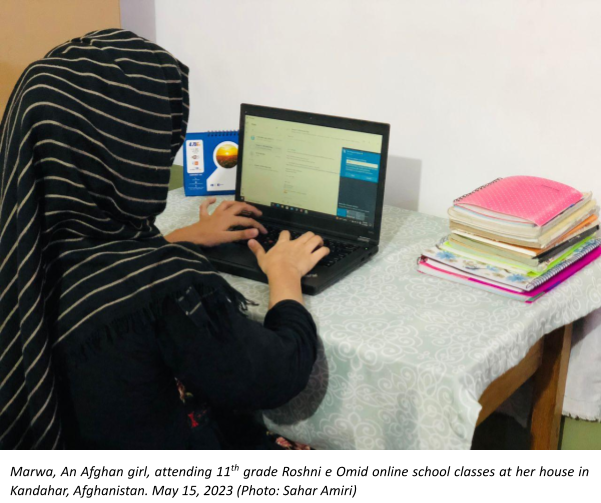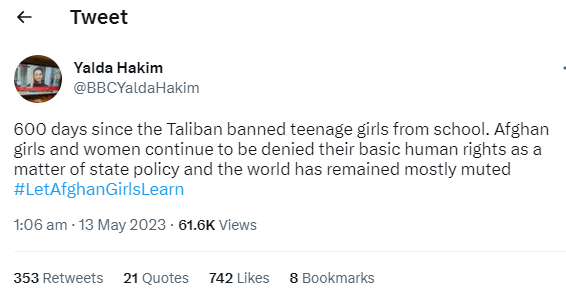On May 13, Afghan girls marked 600 days shut out of school. For over 600 days, the sound of girls’ laughter and chatter in school corridors has been replaced by silence. The Taliban’s ban on school education for girls in Afghanistan has robbed millions of girls of their right to an education, leaving them trapped in a cycle of poverty and despair. Denied the opportunity to learn and grow, these girls are at risk of being forced into early marriage, subjected to violence, and denied a chance to fulfil their dreams. The ban on girls’ education is not just an attack on their fundamental rights; it is a tragedy for the future of Afghanistan.
The closure of schools and universities for girls in Afghanistan has had a devastating impact on the education of millions of girls. However, in recent years, the emergence of online education, offering opportunities, and on-campus scholarships has provided new hope for Afghan girls. While such resources for Afghan girls are tiny, a small portion of Afghan girl students are able to access what would otherwise be unavailable to them via the internet.
Roshni e Omid – an online education program that provides online education to school girls in Afghanistan – gave us a chance to explore the challenges that school girls faces while attending online classes in Afghanistan.
Marwa, an 11th-grade student with Roshni e Omid who takes online classes from Kandahar province, says that her dreams shattered over time as her school remained closed. She saw herself as lucky to seize the opportunity of attending online classes. Marwa struggled to keep pace with online coursework and found navigating online classes complex, but determination in the face of such adversities propelled her forward. Marwa’s story is a testament to the strength and resilience of Afghan girls in the face of adversity, but a minimal number of girls like Marwa have the chance to beat the odds in Afghanistan.

While online education has provided a vital lifeline for many Afghan girls deprived of access to traditional schools and universities, it is important to acknowledge that there are significant limitations in the context of Afghanistan. Online education requires access to reliable technology and internet connectivity, and in terms of connectivity, Afghanistan is ranked the lowest in the world.
Moreover, online education exacerbates existing educational inequalities, as students who lack access to reliable technology and internet connectivity cannot fully participate in their courses. This inequity is compounded by widespread poverty in Afghanistan. In Afghanistan, where GDP per capita dropped from $516 in 2020 to $368 in 2021 and likely even lower now, and where 97 percent of the population is at risk of poverty, the cost of an internet data package at $7 is exorbitant. The high prices pose a significant barrier to accessing online resources and educational opportunities for the majority of Afghan people.
Even for those who can access online learning, there may be difficulty maximizing the benefits. In the Afghan context, the country’s educational system is very traditional and oriented toward in-person instruction. Online education often fails to provide the same level of support and resources as conventional institutions – and many Afghan girl students struggle to succeed in the absence of in-person instruction and academic guidance. The Afghan school curriculum also does not include computers and information technology subjects; as a result, Afghan girls often lack digital literacy skills. Therefore, while online education has undoubtedly provided new opportunities for some Afghan girls, it is not a substitute for a comprehensive, equitable education system that can provide all students with the resources and support they need to succeed.
In the wake of the education crisis in Afghanistan for girls, a limited number of organizations are helping to Afghan girls access education, either online or by providing other alternative educational opportunities. The international community has struggled to provide meaningful support to Afghan girls in the wake of school closures in Afghanistan. Despite ongoing efforts to engage in dialogue with the Taliban about the reopening of schools and the importance of girls’ education, schools have remained firmly shut for nearly two years for Afghan girls, and access to online educational resources and scholarships remains tiny and severely limited. This failure to provide meaningful support reflects the broader challenges of addressing systemic misogynistic and apartheid policies in Afghanistan. It underscores the urgent need for continued advocacy and support for the rights of Afghan girls to education and equal opportunity.
In response to the education crisis in Afghanistan, a Twitter campaign with the hashtag #LetAfghanGirlsLearn has garnered widespread support worldwide. This campaign advocates for the reopening of schools for girls and has served as a platform for individuals to express their solidarity with Afghan girls and their right to education. By bringing attention to the ongoing crisis in Afghanistan, the campaign emphasizes the urgent need to ensure immediate access to schools and universities for girls. Despite the persistent challenges girls face in Afghanistan, the #LetAfghanGirlsLearn campaign stands as a potent reminder that the struggle for girls’ education under the Taliban in Afghanistan is far from over.

Therefore, while the emergence of online education as an alternative in Afghanistan is commendable, it is crucial to continue working toward creating a more equitable and accessible education system in Afghanistan. The international community can play a significant role in this effort by providing support for expanding access to digital tools and resources and offering scholarships and grants to help girls pursue their education during this difficult period.
Additionally, keeping an open dialogue with the Taliban is important to push for the reopening of schools for girls, to ensure that all girls have access to education in the future. It is only through a comprehensive approach that we can ensure that all girls in Afghanistan have equal access to education.

































